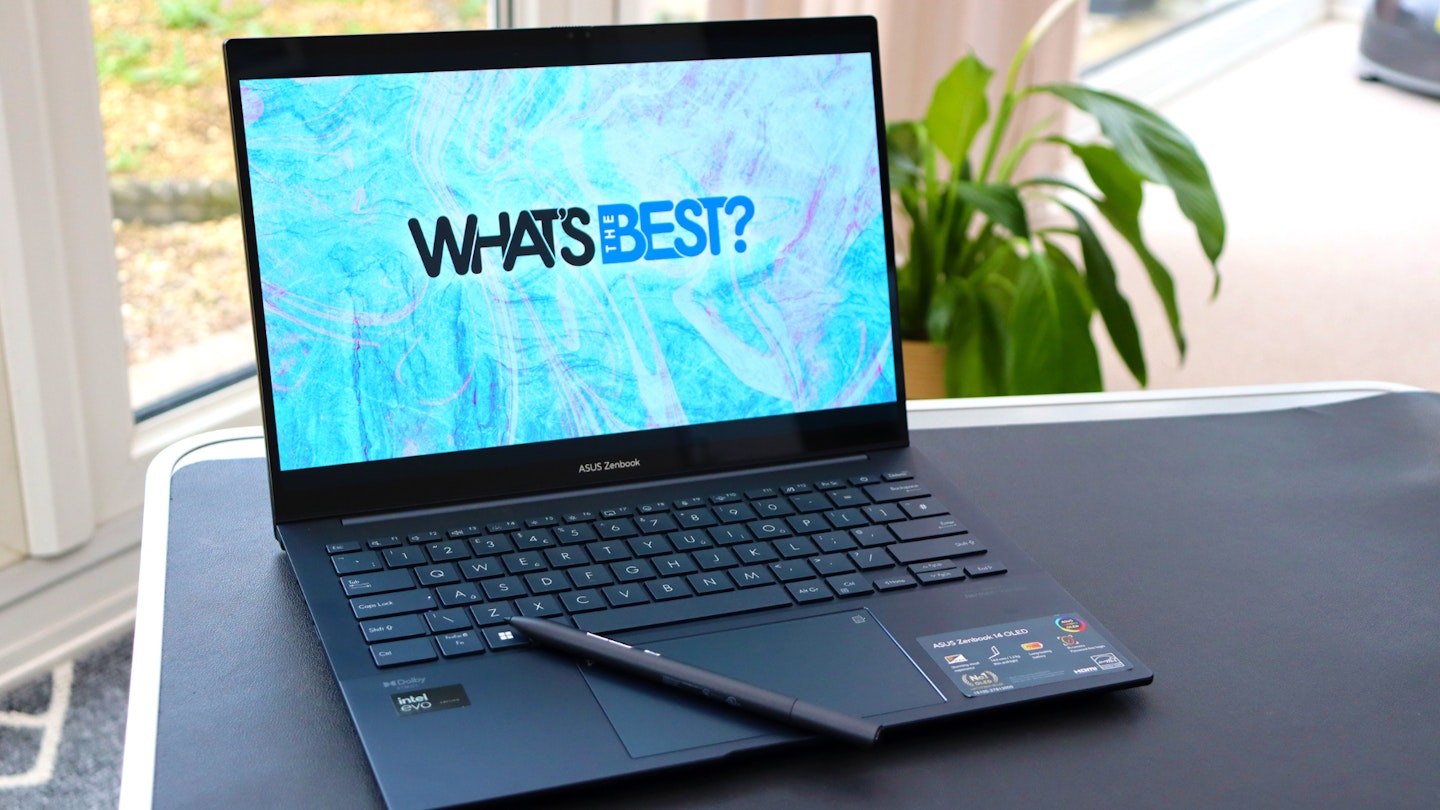Spend enough and your next best laptop could outperform the average PC. And that's thanks to the ever-smaller yet increasingly powerful tech crammed into their slimline cases. Just a quick glance at the spec sheet for this ASUS Zenbook 14 OLED laptop shows that it’s fully loaded when it comes to sound and vision. It's squarely aimed at those who want a premium entertainment and creative media machine with good portability.
Anyone looking at the ASUS Zenbook range will be familiar with the high-end features and performance they offer. OLED screens are arguably the star feature of the line-up, but this particular Zenbook is a 14-inch laptop that boasts some truly outstanding features. Together, they're a clear indication of where ASUS thinks its strengths lie.
The combination of touchscreen, Dolby Atmos sound (via Harmon Kardon speakers) and the included ASUS Pen gives this laptop enormous potential. It doubles as an audio-visual entertainment powerhouse and as a laptop for graphic design and photographers. Not many laptops of this size come this well-equipped.
Our tech expert Chris Duffill has flipped the lid on the ASUS Zenbook 14 OLED, installed his favourite apps and put it to the test. Are those premium features a great match for the rest of the machine, or is it just an average performer topped with a handful of high-tech perks? Let’s find out.

The Quick Version
The ASUS Zenbook 14 OLED impresses with its sleek dark-blue metallic case and OLED screen. Its powerful internals include an Intel i7 processor, 32 GB of RAM, and a 1TB SSD. It excels in displaying 4K HDR movies with vibrant colours and deep blacks, although the glossy screen can reflect light. Its sound system, enhanced by Dolby Atmos and Harman Kardon, provides exceptional audio quality for both movies and music. The laptop also supports creative work with the ASUS Pen and Photoshop, offering high performance. However, its capabilities as a gaming laptop are limited due to the mid to low-end Intel GPU.
The design is durable and stylish but with slightly limited port options. The touchscreen is a welcome and highly usable addition. That said, it doesn't fully fold back, impacting its usability as a tablet-style creative tool. Battery life is respectable, and the laptop remains cool and quiet under load. Overall, the ASUS Zenbook is recommended for those seeking a portable entertainment and creative workstation. As such, its OLED screen and superior sound system are the stand-out features.
 ASUS
ASUSwww.currys.co.uk
Pros
- Stunning OLED touch screen for beautiful visuals and tablet-like control
- Excellent Dolby Atmos sound via Harmon Kardon speakers
- Included ASUS Pen makes this laptop a portable creative tool
Cons
- The Intel Arc GPU is fine for general use with movies and graphics apps, but not for medium-high level gaming
| CPU | Intel Core Ultra 7 Processor 155H 3.8GHz |
| GPU | Intel Arc Graphics (Intel Arc 8-Cores iGPU - ID 7D55) |
| RAM | 32GB |
| Storage | 1TB M.2 NVMe SSD |
| Display | 2880 x 1800 pixels, 14.0-inch OLED touchscreen |
| Battery life | Approx 8 hours |
| Dimensions | 31.24 x 22.01 x 1.49 ~ 1.49 cm |
| Weight | 1.28 kg |
- Customer review: “The screen is stunning, I must say that watching films and TV on the OLED display is a treat and the colour accuracy is fantastic. Additionally, the touchscreen is highly responsive and saves me a significant amount of time when compared to using the trackpad.”

Performance and user experience
ASUS Zenbook: First impressions
Opening the muted metallic deep-blue lid, the first thing I noticed was the inky-black OLED screen. I was eager to test it with some 4K HDR movies right away. The ASUS Pen also gave me the creative itch to get Adobe Photoshop installed and test the pressure sensitivity on that glass touchscreen. The understated Dolby Atmos and Harmon Kardon logos on either side of the trackpad hint at excellent audio capabilities too, so music and movies were what I wanted to explore first.
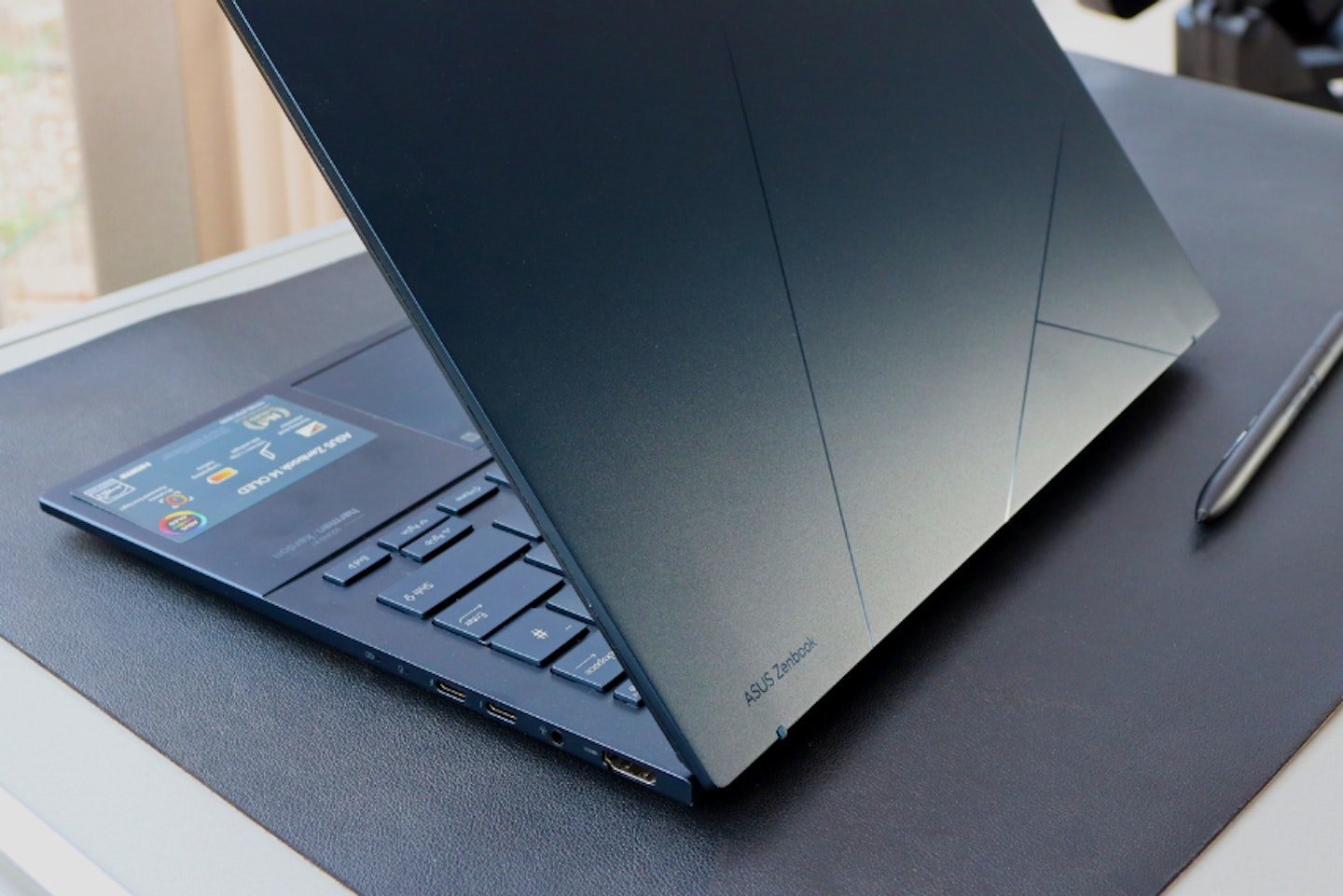
ASUS Zenbook: Under the hood
Excitement aside, I wondered if the ASUS Zenbook had the grunt to run everything I was about to throw at it. Behind that OLED touchscreen, trackpad and backlit keyboard lies an Intel i7 processor, 32 GB of RAM and a 1TB SSD. Altogether, that’s enough computing power and storage capacity to support professional applications running under Windows 11 Home.
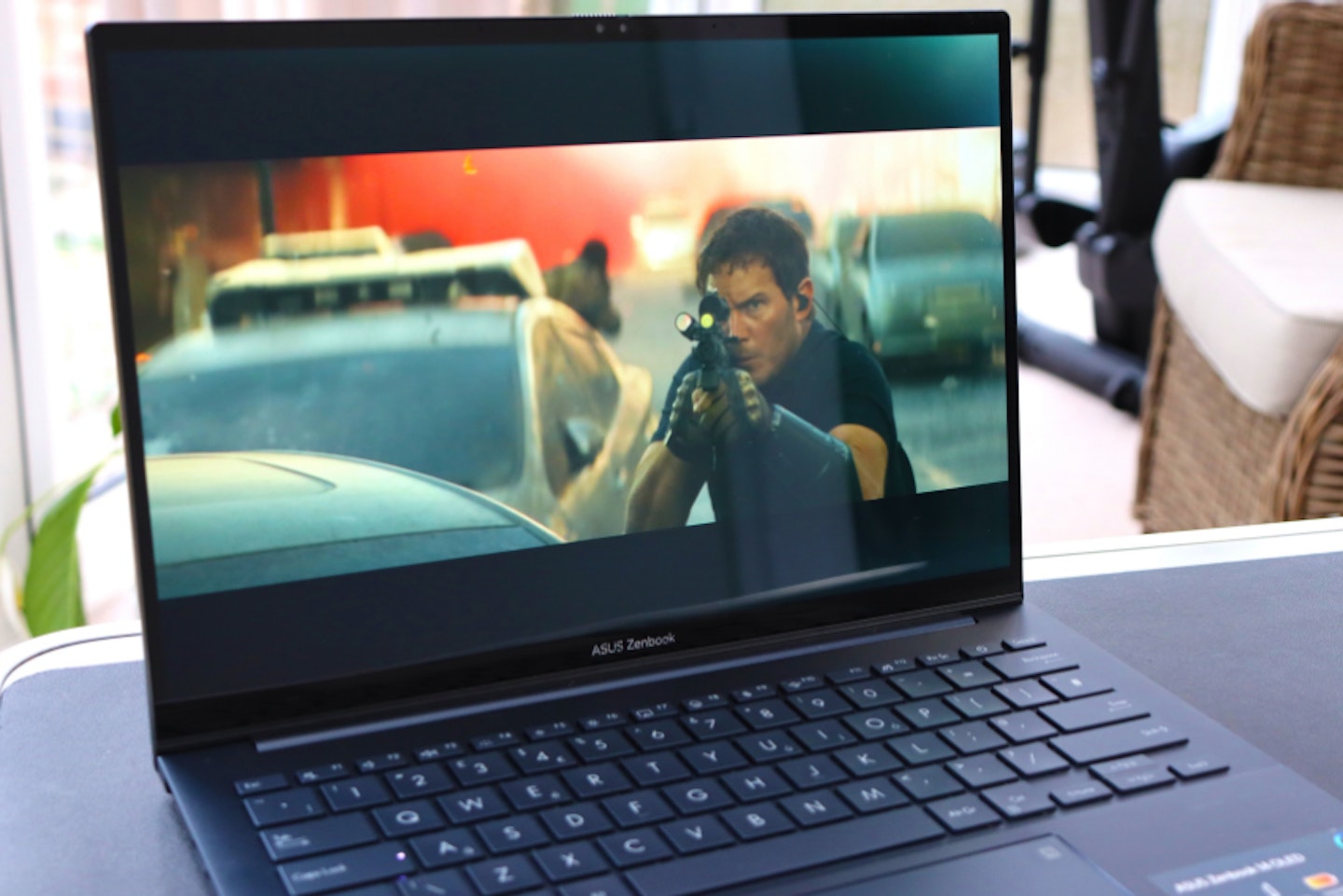
ASUS Zenbook: Movies
I set about installing the Amazon Prime Video app and, as expected, it installed and ran super-fast. 4K HDR (High Dynamic Range) content is easy to come by on Prime - but I had to enable HDR in Display Settings first. So, with that done, I hit the play button.
And wow - the OLED display really delivers the inky blacks and vibrant HDR colours I was hoping for. Although HDR is leagues ahead of the standard colour range, the rest of the viewing experience was a little tricky thanks to the slightly shiny screen. Testing in the daytime with indirect sunlight meant I needed to adjust the screen position. Later, I watched a movie in a darkened room, which was a flawless experience. The Dolby Atmos sound was a genuine surprise to me. The downward-firing speakers absolutely delivered excellent bass levels and more separation than I was hoping for. Considering this is a laptop, I was seriously impressed.

ASUS Zenbook: Music
Playing my music of choice via the Spotify app, the speakers and sound system proved excellent for music too. Playing a mixture of genres (including some serious guitar shredding courtesy of AC/DC) the sound held together - even at higher volumes.
Harman Kardon is a speaker brand I’m familiar with, and it’s been included here as part of a well-designed integrated sound system. ASUS has also included the Dolby Access app for tweaking settings and more; Interesting but I was happy with the sound profile right out of the box.
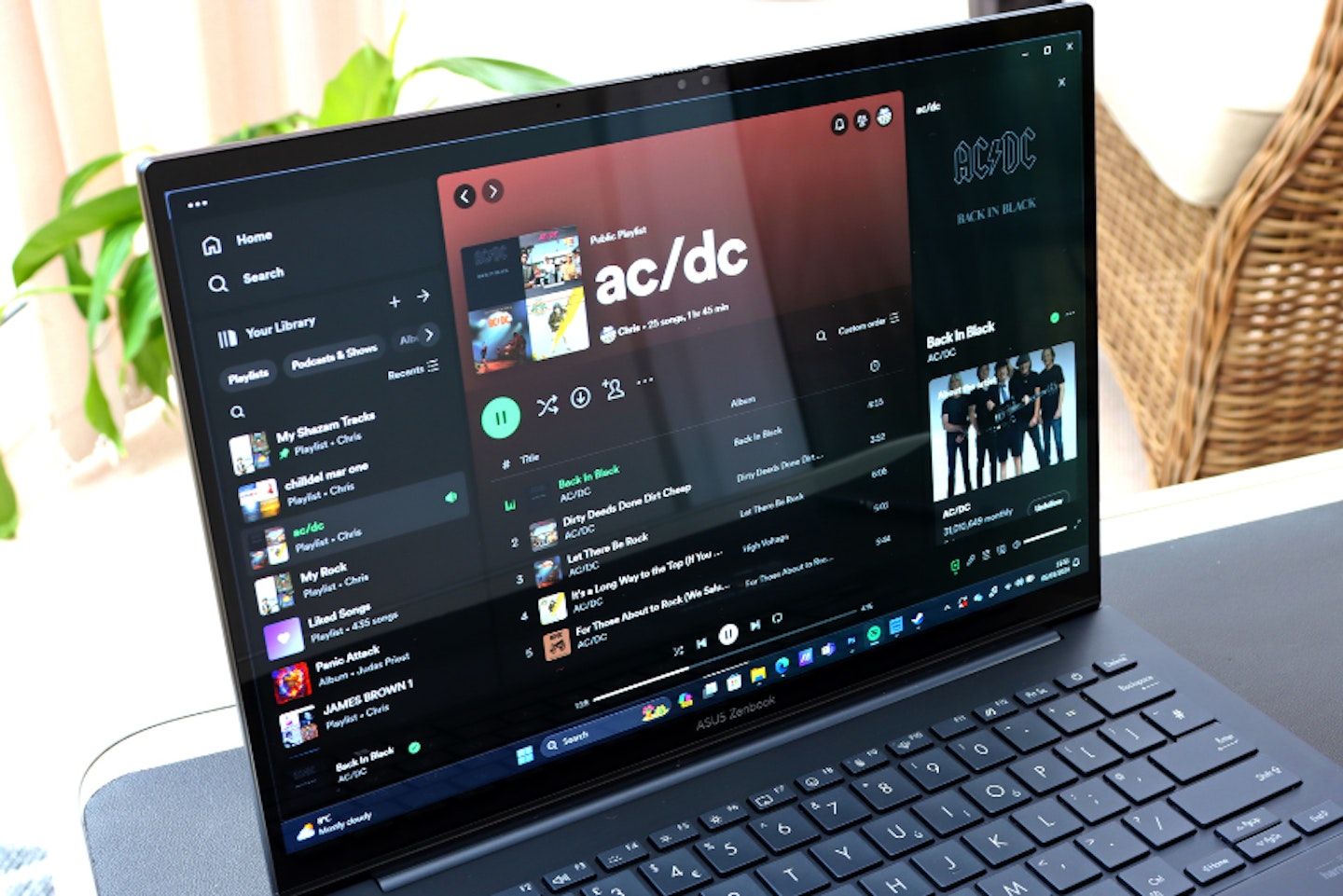
ASUS Zenbook: Creativity
I’m also a photographer and graphic designer, so I wanted to see if I could run Photoshop on the ASUS Zenbook. The included ASUS Pen charged via USB-C in about 10 minutes and paired using Bluetooth.
Installing Photoshop via Adobe CC was seamless. it loaded in a speedy three seconds flat. My go-to creative test with any new computer is the speed and smoothness of the airbrush tool. Selecting a pressure-sensitive brush, I could draw at my own speed without any stuttering. I also kept Amazon Prime Video, a browser, Teams, Spotify and Steam open in the background for this test; none of which affected Photoshop performance.
I found the pen sensitivity a thing of beauty, working flawlessly with brushes in all modes. Plus, holding down the upper Pen button handily pops up the brush selection menu when you're using the canvas. Its default is a right-click on a mouse. A final test was editing photographs in RAW format as this involves larger file sizes and extra processing power. As expected, this was smooth and responsive - and the images looked fantastic thanks to the OLED display. Any photographer will love the colour fidelity here. This machine probably makes it into my top ten picks for a great laptop for photo editors.
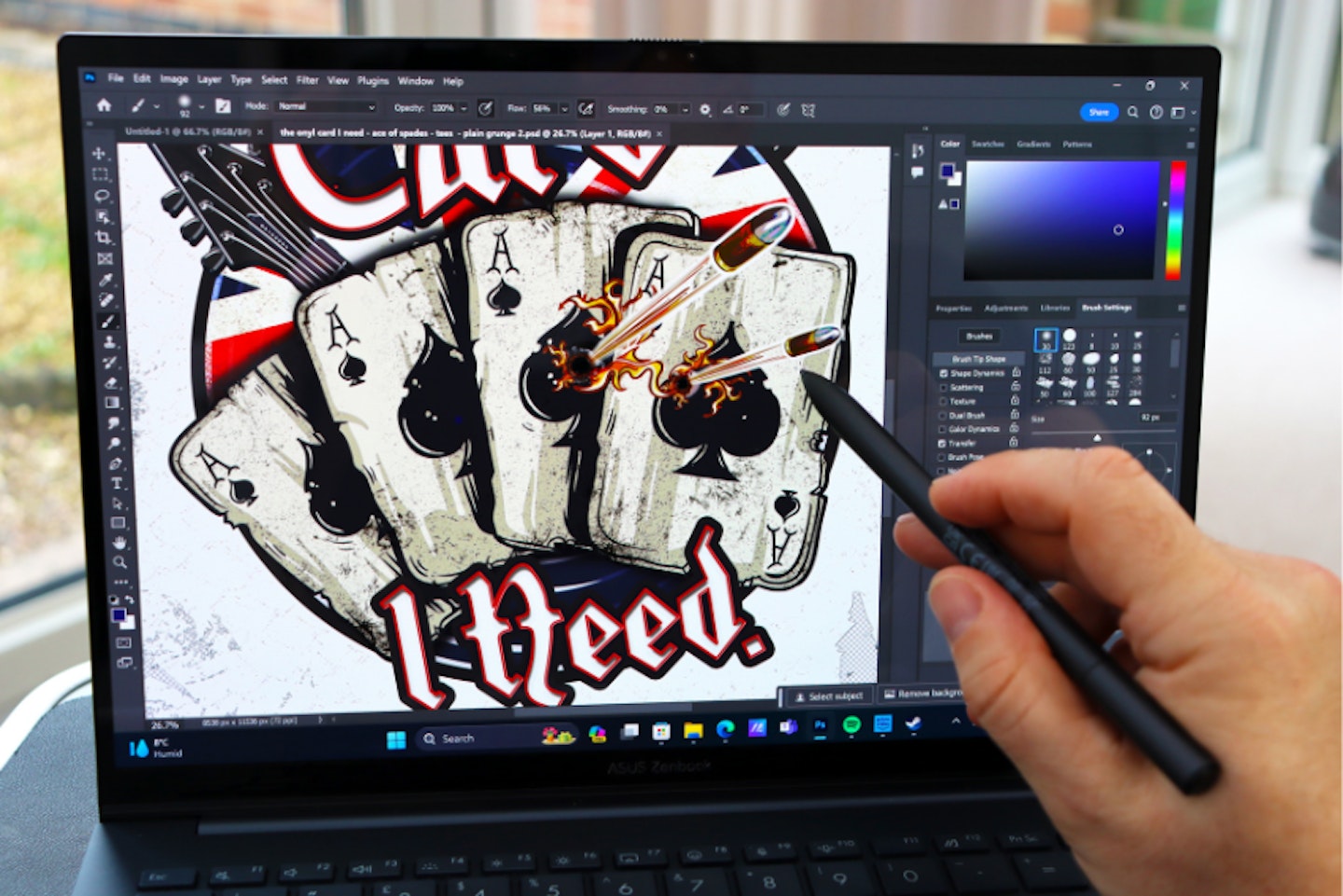
ASUS Zenbook: Gaming
This laptop has an Intel GPU that sits in the same camp as other mid to low-end mobile graphics processors. So, I didn’t have high expectations for gaming. Installing Steam and firing up Halo Infinite was, perhaps, a little optimistic of me. And I was right. Even at minimum graphics settings, I was soon getting thrashed in multiplayer thanks to a truly abysmal framerate.
Switching to the EPIC Game Launcher for a bit of Fortnite Battle Royale, the story was much the same. In the end, I was able to achieve a fairly stable 30 frames per second. In short, this laptop may be a stellar performer with video and design packages - but mid to high-level 3D gaming is asking too much.
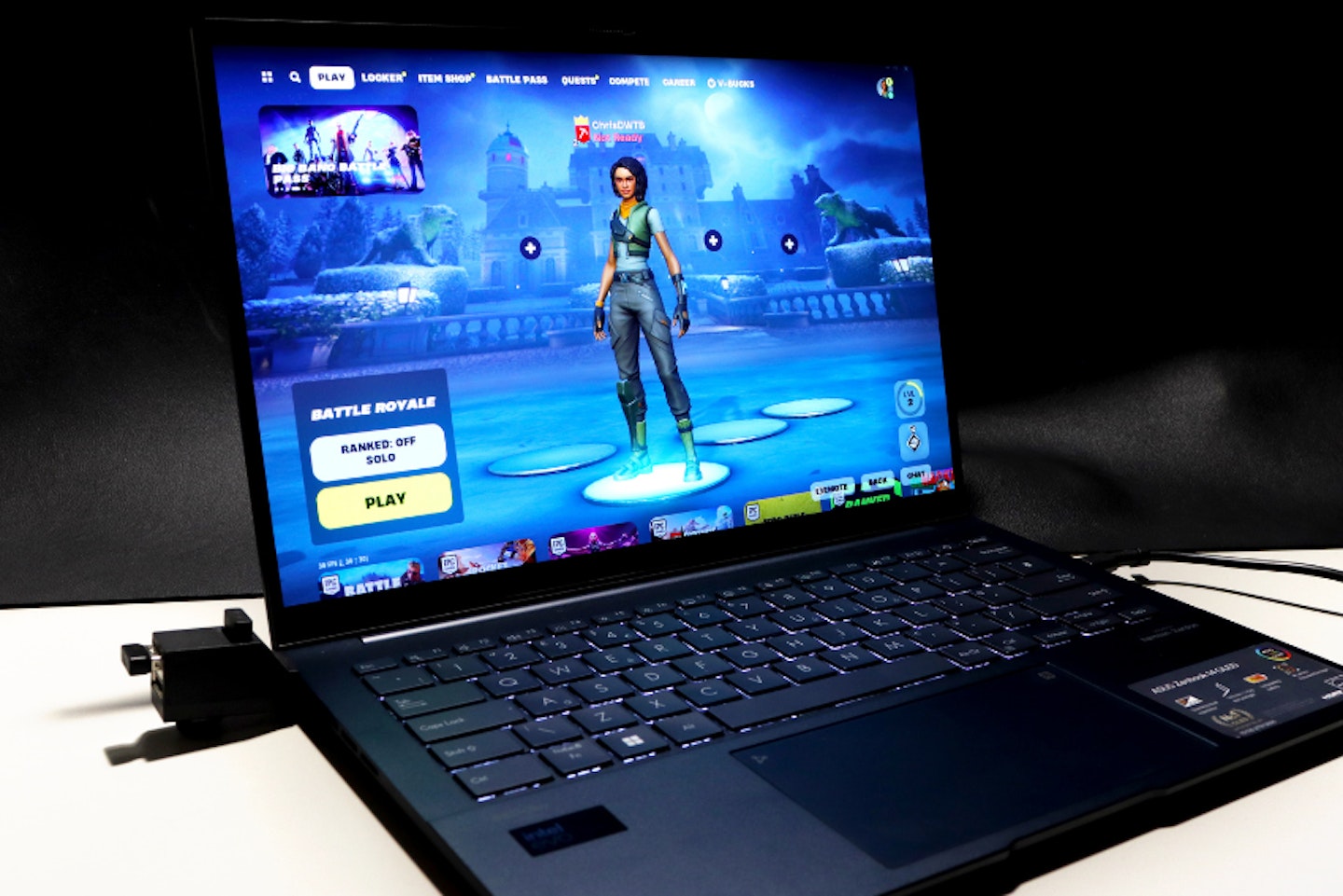
ASUS Zenbook: Everyday use
As a Windows laptop for browsing the web and writing, the ASUS Zenbook is light enough to perch anywhere and remain stable. I find the low-profile keys have a solid feel and are responsive yet quiet in operation. I also appreciate the oversized and gently contoured keycaps - typing was a reassuringly accurate pleasure. I found that the Touchpad supports multiple gestures for scroll zoom and more. Thankfully, I was able to increase the tap sensitivity - I had to set it to maximum to be usable.
For making video calls, the onboard camera and mic (which has two-way AI noise cancellation) were excellent. Calling a colleague on Teams resulted in a smooth HD picture, clear voices and the added benefit of automatic face recognition. The latter meant that an automatic digital pan and zoom function would keep me centred in the frame.
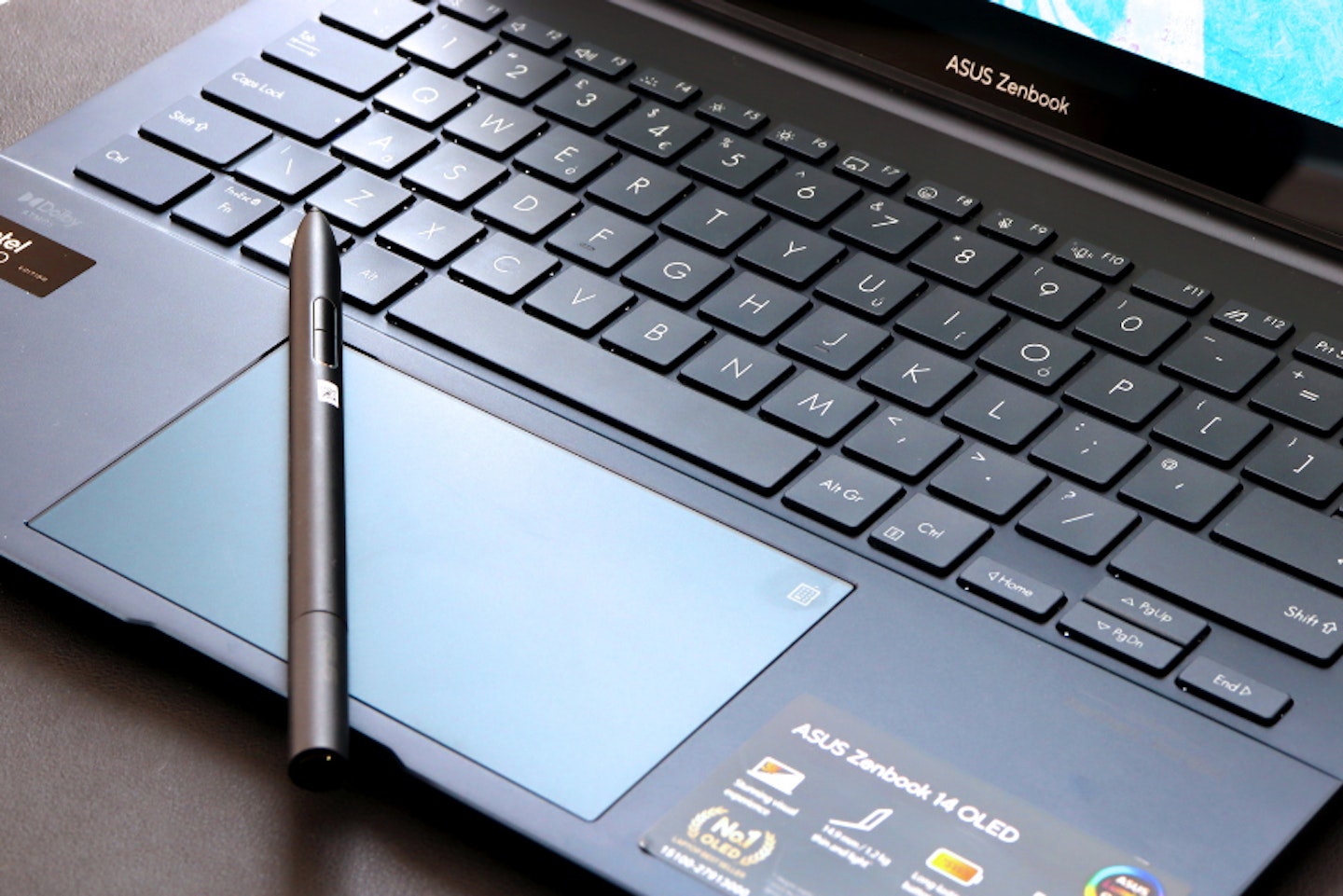
Build
Case build and design
ASUS claim that the Zenbook is made with military-grade durability. I can believe it, but I wouldn’t like to test that claim. The laptop isn’t feather-light, nor is it heavy. However, it is slim - and despite some notches in the front profile, I found it tricky to open while holding it at times. That slightly metallic blue finish and OLED screen would really show up any dents and scratches. Using it every day is a reassuringly solid experience, though. The design is refined and I appreciate the dark blue colour.
One slightly odd (but understandable) feature is the light-up numpad that shines through the trackpad. It looks cool, and I did use it with the calculator app. But, having to click the trackpad for each number was a little hit-and-miss.
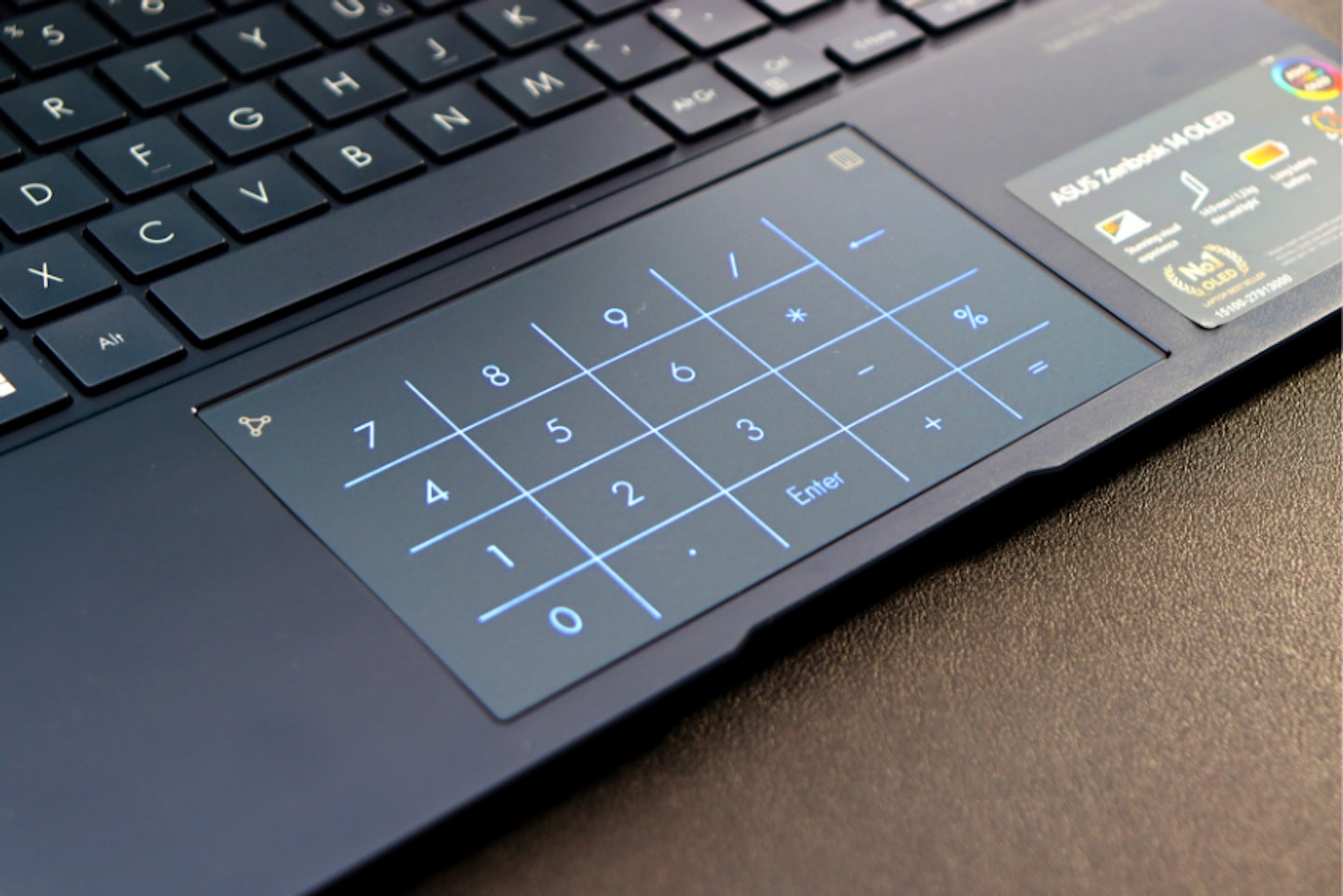
Display and ASUS Pen
The OLED display doesn’t appear to have any outstanding anti-glare capabilities. It’s the only downside to what is a stunning screen. Made even better by the slim bezels on either side, at times I forgot this was just a 14-inch laptop.
I soon discovered that the pen has a lot of glide on the glossy glass screen. It is usable - but not as responsive or natural-feeling as a Wacom tablet. Also, as the screen doesn’t fully fold back into tablet mode, I found my hand had nowhere to rest while using the pen. It’s a great pressure-sensitive addition for anyone who needs to be creative on the go, but using it for hours would have been an issue for me.
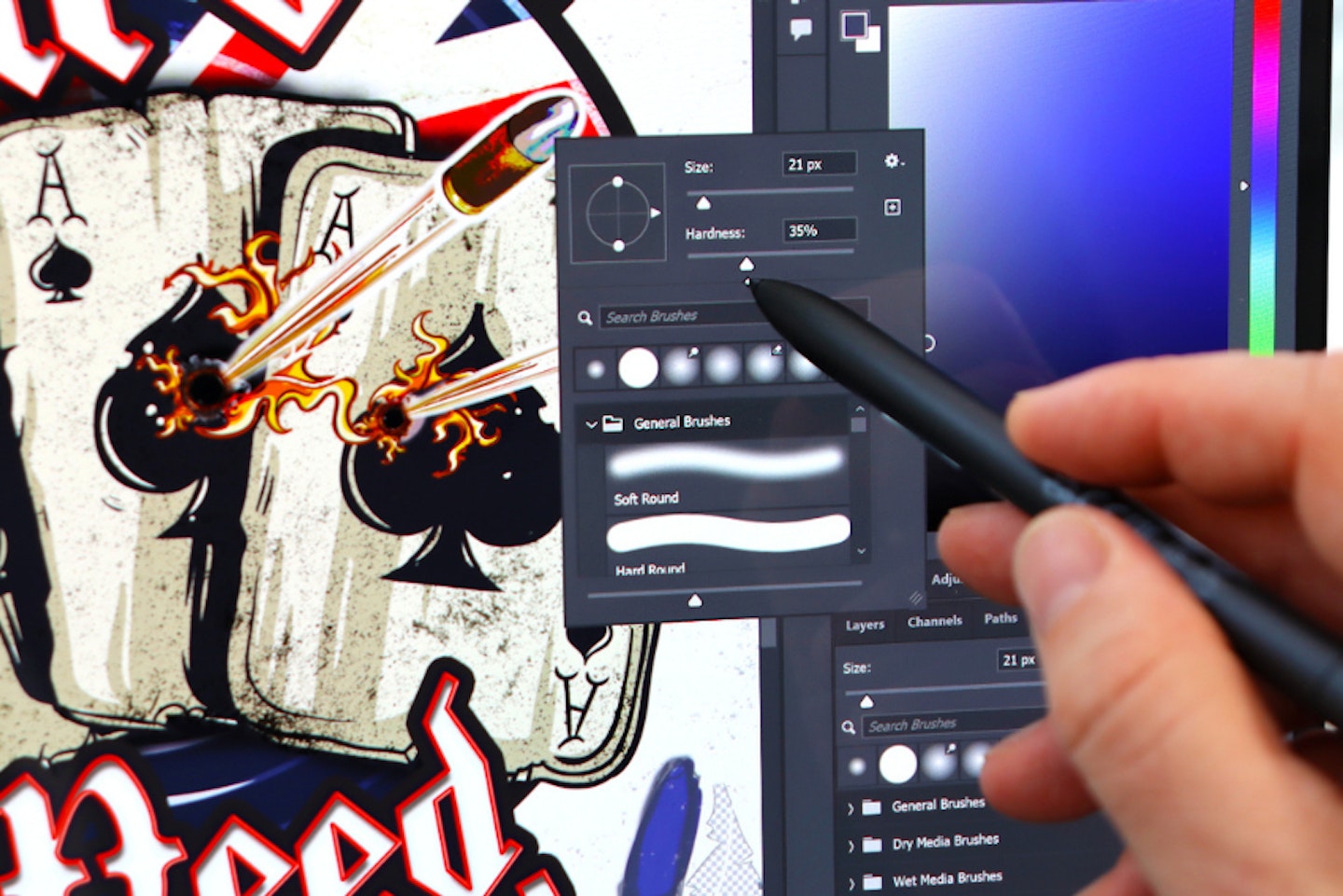
Ports
Aside from a single HDMI port and a couple of USB-C ports, I found the ASUS Zenbook to be thin on the ground for connectivity. Although typical of most slim laptops, I do find that having to resort to hubs to connect both my keyboard and mouse at once is a pain. One extra USB port would make all the difference.
Battery life
Having arrived with a super-low battery, I charged the Zenbook for four hours to reach 100 per cent capacity. After one hour of Photoshop, it was down to 91 per cent. I ran Teams, Spotify, Photoshop, Steam, and Edge and played a 4K movie all at once. The battery lasted a more than respectable five-and-a-half hours more.
Fans, noise and heat
Thankfully, even while putting the laptop through the punishing battery test above, it didn’t get overly hot. As most of the ventilation is on the underside, it can get fairly warm to the touch under heavier workloads; I wouldn't want this on my lap for too long if I were pushing its limits. That said, the fans are not much more than a whisper, so it’s clearly an efficient design when it comes to head dispersion.
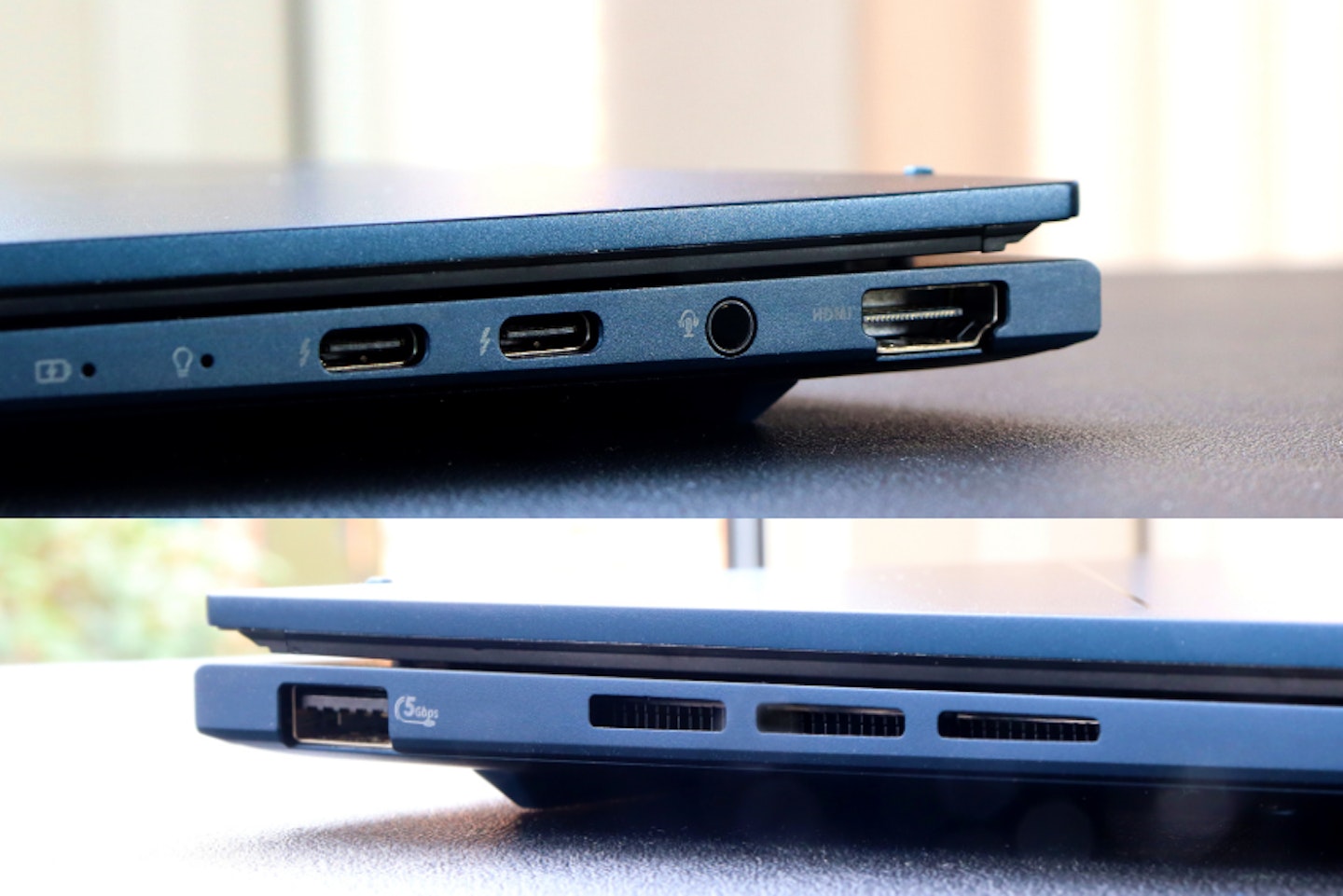
Price and competition
Laptops at the smaller end of the scale with OLED screens are a little thin on the ground. It’s also a little unusual to find a 14-inch laptop that has the kind of RAM and SSD specs that this one has. For the price (considering that many laptops under £1000 often have much less to shout about) I think that this ASUS delivers a little more than the price tag would suggest. But, if you’re all about the quality of the screen for your entertainment (and don’t mind lugging around something larger and heavier) movie fans might consider the Samsung Galaxy Book4 Pro Laptop. It might not be as portable as the ASUS Zenbook 14 OLED laptop, but it does at least have an AMOLED display and great Dolby Atmos sound.
As for serious creatives, I think that the ASUS Zenbook Flip 14-inch laptop is a great alternative. And that's simply because it does as the name suggests - flipping its screen backwards turning the laptop into a tablet. It’s ideal for a more natural drawing position using the ASUS pen and even has an OLED panel and Dolby Atmos sound. However, it does only have half as much RAM and SSD storage as the one I reviewed here.
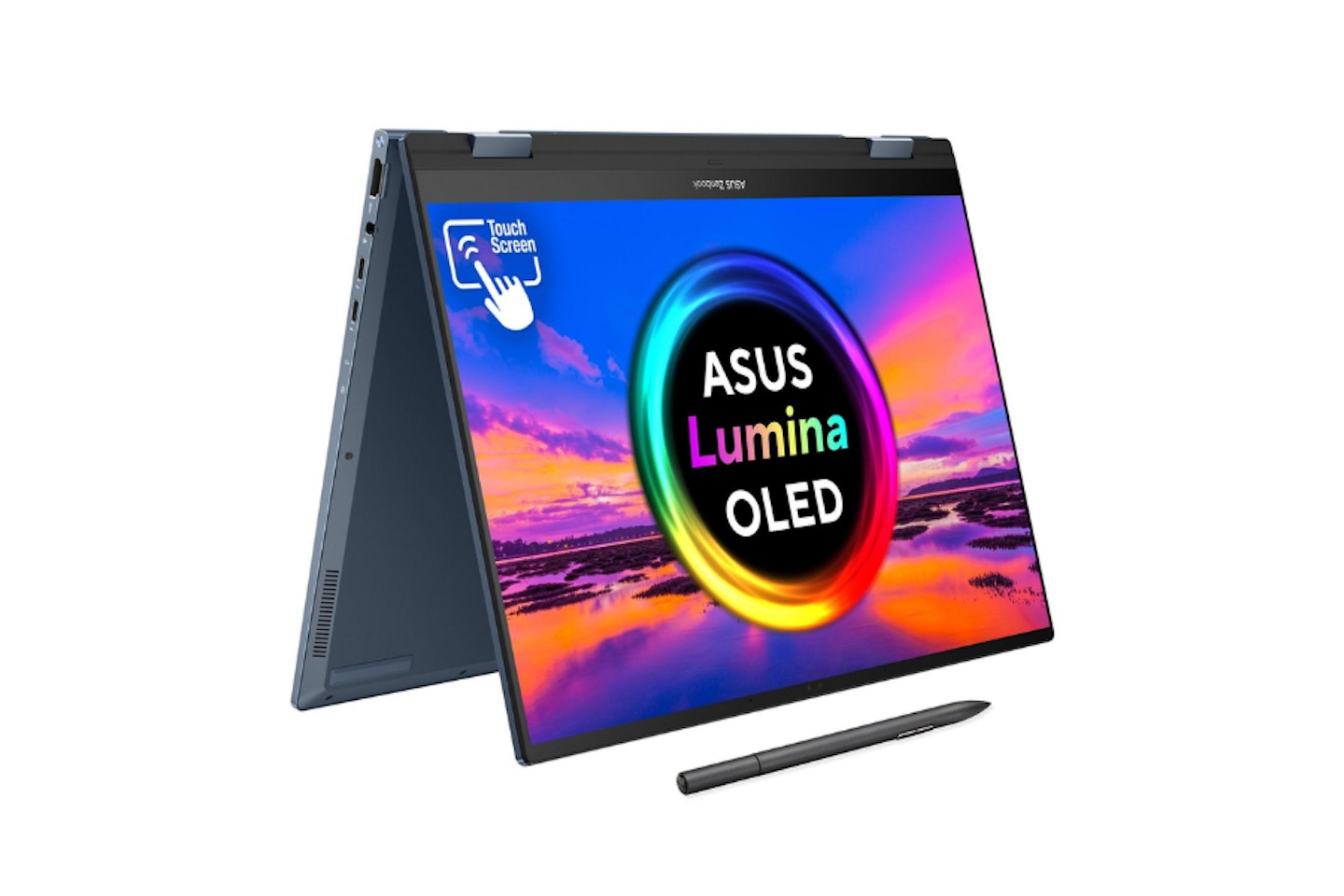 ASUS
ASUSwww.very.co.uk
Whereas the non-Flip versions of ASUS Zenbook laptops tend to have more powerful internal specifications, this one retains much of the benefits of their slightly chunkier cousins. The OLED touchscreen and included ASUS Pen are present, as is the amazing Dolby Atmos and Harmon Kardon speaker setup.
Best of all, creatives can flip the screen all the way back - making for a more natural drawing position for using that pen stylus. But, as mentioned, while you do get to keep some of those high-end features you do lose some of the CPU, RAM and storage specs of non-Flip laptop versions, despite the similar price point.
Pros
- Fully foldable touch screen for great tablet-like form factor
- OLED panel and ASUS Pen make this a great choice for creatives
- Harman Kardon-certified Dolby Atmos sound system for awesome audio
Cons
- The overall internal spec is less powerful than the (non-Flip version) ASUS Zenbook 14-inch laptop
| CPU | Intel Core i7-1360P |
| GPU | Intel Iris Xe Graphics |
| RAM | 16GB |
| Storage | 512GB SSD |
| Display | 14-inch 2.8K (1920x1080) OLED HDR touchscreen |
| Battery life | Approx 15 hours |
| Dimensions | 31.15 x 22.34 x 1.59 cm |
| Weight | 1.28 kg |
- Customer review: “Amazing! Up to speed , had it for few days well cool! However it does feel very delicate whilst in tablet mode but it is us militarily grade durability standards! Surely nothing to worry about!.”
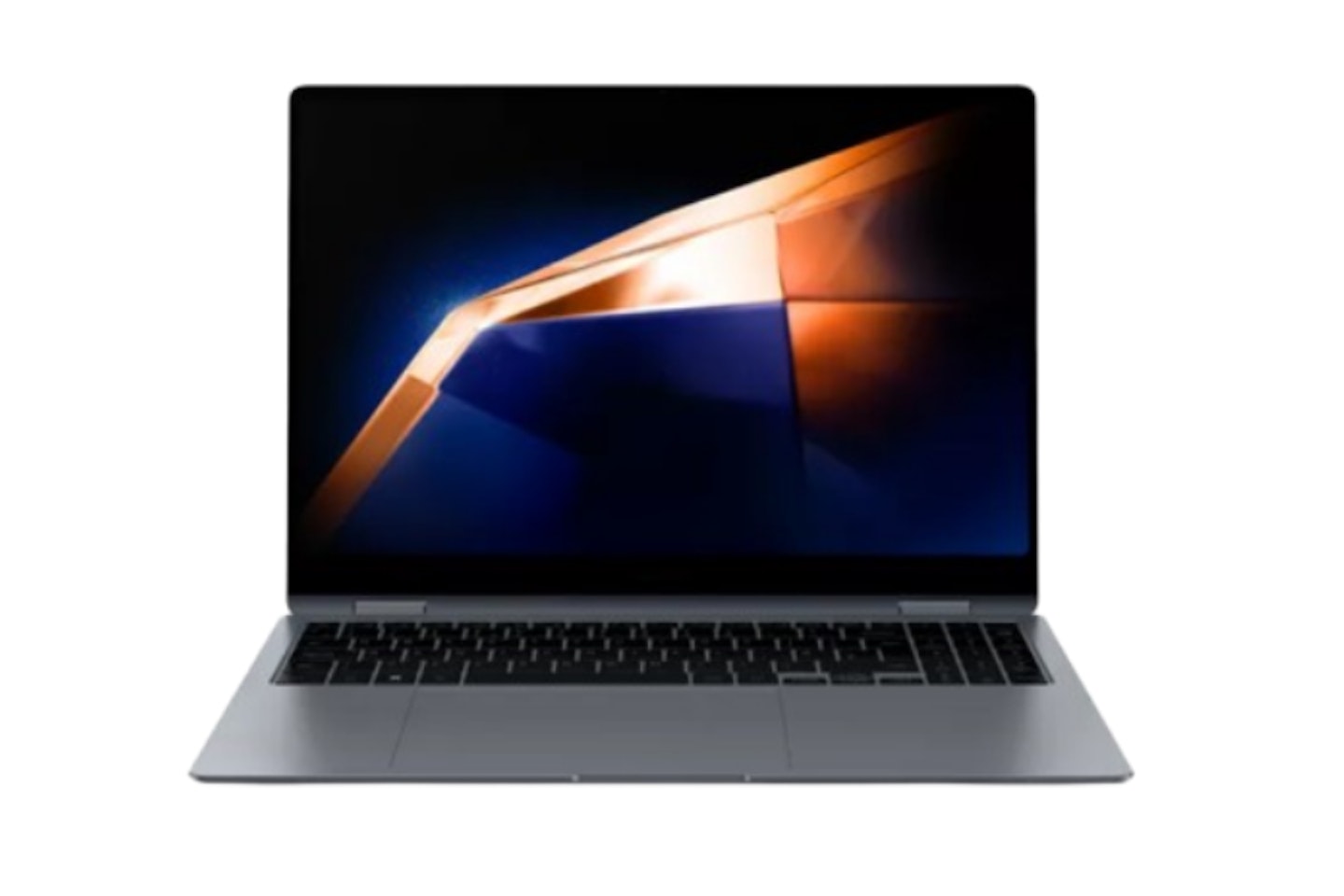 Samsung
Samsung www.johnlewis.com
The more expensive Samsung Galaxy Book4 Pro Laptop shares most of the features of the ASUS Zenbook - such as a fantastic touchscreen display and even Dolby Atmos speakers.
What you're paying for here, aside from the larger 16-inch AMOLED screen to enjoy your movies on, is the Ultra 7 processor with its AI-powered performance; and the overall Samsung design and build. You don't, however, get a stylus pen, it's a little heavier to lug around. The graphics (like the Zenbook) are Intel Arc, and there's also only 16GB of RAM and a 512GB SSD - half that of the ASUS Zenbook reviewed here.
Pros
- 16-inch AMOLED panel is amazing for enjoying movies on the move
- Dolby Atmos quad speaker setup provides even better sound
- Legendary Samsung design and robust build quality
Cons
- Other than the CPU, the internal spec is less powerful than the ASUS Zenbook 14-inch laptop
| CPU | Intel Core Ultra 7 Processor |
| GPU | Intel Arc Graphics |
| RAM | 16GB |
| Storage | 512GB SSD |
| Display | 16-inch WQXGA+ AMOLED Display (2880 x 1800), Anti-Reflective, Touch Screen Panel |
| Battery life | Up to 21 hours |
| Dimensions | 1.2 x 35.54 x 25 cm |
| Weight | 1.56 kg |
- Customer review: “Amazing! Up to speed , had it for few days well cool! However it does feel very delicate whilst in tablet mode but it is us militarily grade durability standards! Surely nothing to worry about!.”
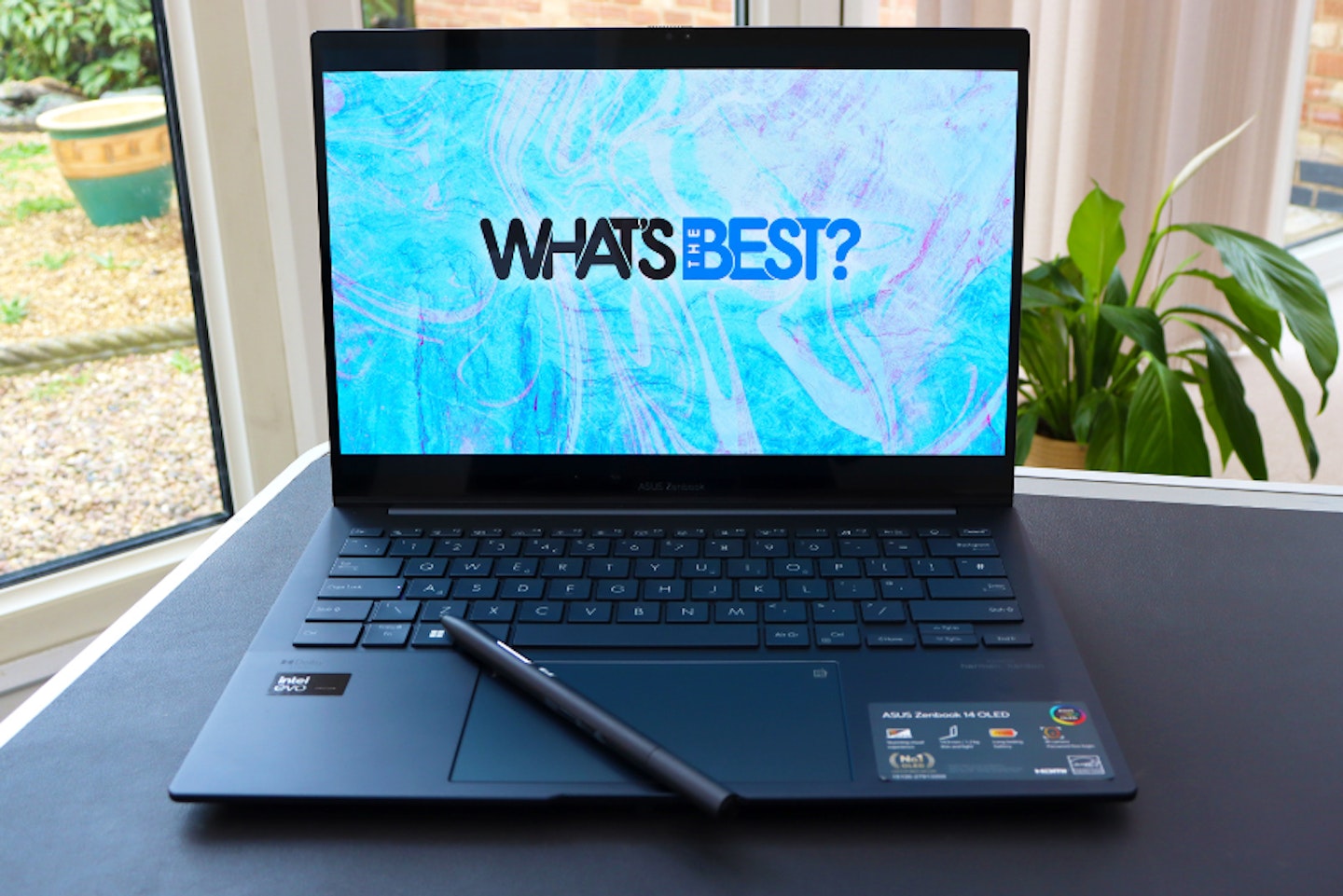
Final thoughts
Who is it for?
This is a laptop for someone who cares about deep blacks and rich HDR colours that only an OLED display can give. It also has enough raw power under the hood (and extras like the ASUS Pen) to make it a serious creative tool for those who like to take their design work on the road. And when you’re done with work, your music or movies will sound fantastic too; Those Harmon Kardon speakers twinned with Dolby Atmos sound deliver immersion and a soundstage not normally associated with small laptops.
Would we recommend it
I think that this ASUS Zenbook 14-inch laptop is a fantastic choice for anyone who wants to enjoy their entertainment on the go. It excels with audio, beating many laptops in terms of the well-rounded and bassy sound. Given that the OLED screen is also a touchscreen that works with the included Pen, there’s a lot of tablet-like functionality to it as well. Although, anyone looking to use this as a daily creative tool or tablet replacement should probably look at the Zenbook Flip for a more comfortable long-term experience.
As a pure entertainment machine for 4K HDR movies and TV shows, the only real downside I found were some reflections on the slightly glossy OLED screen. That being said, if you’re in a room without super-bright reflections you’ll be fine - with careful placement. All in all, this is a very capable laptop that delivers a premium audio-visual experience, plus the portability to pack up your entertainment and creative work and take it all with you.
 ASUS
ASUSwww.currys.co.uk
Pros
- Stunning OLED touch screen for beautiful visuals and tablet-like control
- Excellent Dolby Atmos sound via Harmon Kardon speakers
- Included ASUS Pen makes this laptop a portable creative tool
Cons
- The Intel Arc GPU is fine for general use with movies and graphics apps, but not for medium-high level gaming
| CPU | Intel Core Ultra 7 Processor 155H 3.8GHz |
| GPU | Intel Arc Graphics (Intel Arc 8-Cores iGPU - ID 7D55) |
| RAM | 32GB |
| Storage | 1TB M.2 NVMe SSD |
| Display | 2880 x 1800 pixels, 14.0-inch OLED touchscreen |
| Battery life | Approx 8 hours |
| Dimensions | 31.24 x 22.01 x 1.49 ~ 1.49 cm |
| Weight | 1.28 kg |
- Customer review: “The screen is stunning, I must say that watching films and TV on the OLED display is a treat and the colour accuracy is fantastic. Additionally, the touchscreen is highly responsive and saves me a significant amount of time when compared to using the trackpad.”
Who tested it?
Chris Duffill is one of our commercial content writers specialising in audiovisual and computing. He's also been a graphic designer and videographer, using professional creative software on a wide variety of laptops and desktop computers over the last two decades.
How was it tested?
I used the ASUS Zenbook 14 OLED laptop every day for over two weeks. It arrived with a fresh install of Windows 11 Home and I installed all of the available updates. I also updated the graphics driver from the Intel website. It was used with the latest versions of Adobe Photoshop, Microsoft Teams, the Spotify app, Microsoft Edge, the Prime Video app, Valve Steam and the EPIC Game Launcher.
Chris Duffill is a Tech Product Writer for What's The Best. His background includes writing, editorial, marketing, design, video production and photography.
He specialises in home entertainment and audiovisual tech, including speakers, amplifiers, turntables, streaming media players, and TVs. He is also one of our resident experts in computing (PCs, tablets, smartphones, smartwatches), DSLR photography and all kinds of digital cameras. He also writes about retro gaming, game consoles and various electronic gadgets. If it plugs in, lights up or makes a noise, he’ll write about it.
Subscribe to the What’s The Best Newsletter to keep up to date with more of the latest reviews and recommendations from the rest of the What’s The Best team.
